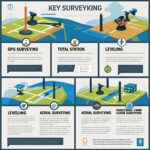Surveying is an age-old and vital discipline that serves as the foundation for infrastructure, property development, engineering, and construction projects worldwide. From mapping ancient civilizations to laying the foundation for today’s skyscrapers, surveying plays a vital role in shaping the environment around us. At its core, surveying relies on five key fundamentals that guide accurate, reliable, and efficient data collection and measurement. Understanding these fundamentals is crucial for both professionals and anyone working in related fields.
1. Measurement
At the heart of surveying is measurement — the precise determination of distances, angles, and elevations. This fundamental involves the use of instruments such as total stations, theodolites, GPS receivers, and laser scanners. Accuracy in measurement is vital, as even small errors can lead to costly mistakes in construction or boundary disputes.
Technological innovations have significantly enhanced the accuracy and efficiency of modern measurement methods. Digital and satellite-based technologies have replaced many manual methods, allowing for real-time data capture and better integration with mapping software.
2. Positioning
Positioning involves identifying precise geographic locations on the Earth’s surface. Surveyors use coordinate systems like latitude, longitude, and elevation to place features or boundaries accurately. This element plays a crucial role in navigation, city planning, and land development projects.
Global Navigation Satellite Systems (GNSS), such as GPS, GLONASS, and Galileo, have revolutionized positioning by providing high accuracy across vast distances. These technologies allow surveyors to operate effectively in remote or hard-to-reach locations.
3. Data Collection and Recording
Surveying isn’t just about taking measurements — it’s about collecting and recording data that can be analyzed and used by others. This includes documenting field notes, maps, digital models, and geospatial data.
Maintaining the accuracy and reliability of data is a core aspect of this process. Surveyors must meticulously record information, often using software that integrates with Geographic Information Systems (GIS) and Building Information Modeling (BIM). This data serves as a foundation for decision-making in projects ranging from highway construction to environmental conservation.
4. Analysis and Interpretation
Once data is collected, the next step is analysis and interpretation. This involves converting raw data into meaningful insights — calculating areas, determining property lines, modeling terrain, and identifying elevation changes.
Professional surveyors apply mathematical and computational techniques to interpret data accurately. This process ensures that the final output, whether it’s a map, a legal document, or a 3D terrain model, is reliable and actionable.
5. Communication and Presentation
The final fundamental is communication. Surveying results must be clearly communicated to engineers, architects, government agencies, and clients. This is achieved through maps, reports, digital models, and presentations.
Clarity and precision are essential. A well-documented boundary survey or topographic map can prevent legal conflicts, while a clear 3D model can aid architects in planning safe and efficient structures. In today’s digital era, surveyors increasingly rely on visual tools like drones, 3D laser scans, and augmented reality to present data in more interactive and understandable formats.
Conclusion
Surveying is far more than simply measuring land — it’s a complex discipline built upon five fundamental pillars: measurement, positioning, data collection, analysis, and communication. These principles ensure that surveyors provide accurate, reliable, and actionable information across countless industries. As technology evolves, the core values of precision and integrity remain at the heart of surveying, helping us map and shape the world with confidence.








